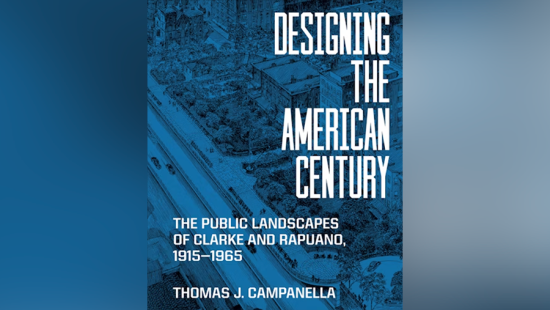John W. Reps, 1921–2020
CRP faculty share recollections of Professor Emeritus John Reps, noted historian of urban planning, cherished mentor, and pioneering authority on American urban iconography.
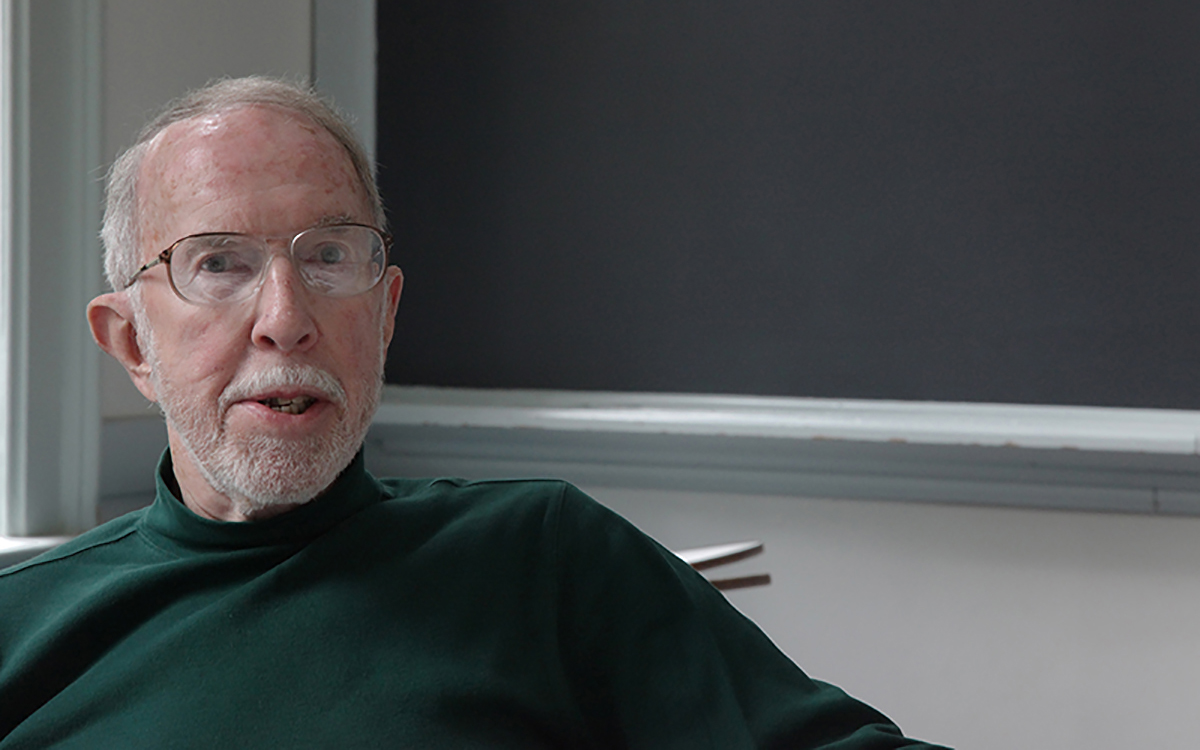 Professor Emeritus John Reps, CRP, in 115 West Sibley Hall, 2010. William Staffeld / AAP
Professor Emeritus John Reps, CRP, in 115 West Sibley Hall, 2010. William Staffeld / AAPAlumnus, professor emeritus, and former department chair John Reps, whose commitment to the Department of City and Regional Planning (CRP) spanned more than 70 years, passed away at home on Thursday, November 12, just shy of his 99th birthday.
In a message to the AAP community, Dean J. Meejin Yoon called Reps "truly one-of-a-kind."
"John held a unique place in the college, though his influence extended well beyond our campus," and "brought deep, scholarly, humanist values to decades of teaching," wrote Yoon.
After graduating as part of the first class of students to confer master's degrees in city and regional planning at Cornell in 1947, and several years of study in England both at the University of Liverpool and the London School of Economics, Reps returned to Ithaca in 1951 to join the planning department as a member of the faculty. His service to CRP took almost every form imaginable. Reps taught lecture courses and seminars and chaired the department for twelve years, acting simultaneously as the department secretary as well as director of admissions, commencement, and scheduling as he wrote books and papers, documented cities and towns, and collected historical city plans.
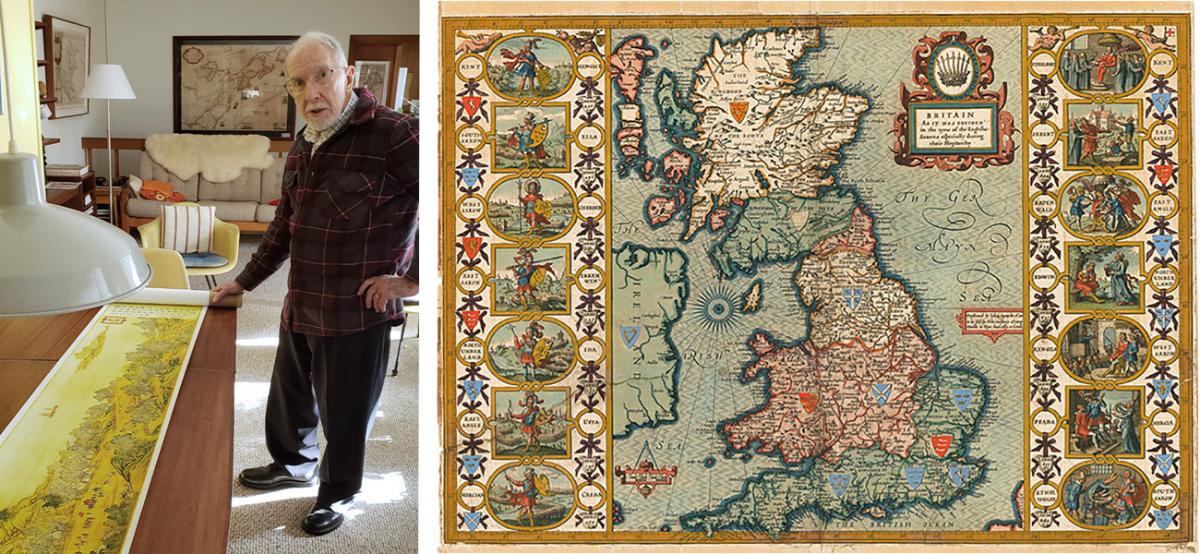 John Reps took great interest in a range of representations of urban spaces, geographies, and landscapes around the world. Over the course of his career, he amassed an extensive collection of illustrations and prints, maps and plans, and documentary photographs. Left: John Reps, image / Thomas Reps; right: image / Historic Urban Plans Collection
John Reps took great interest in a range of representations of urban spaces, geographies, and landscapes around the world. Over the course of his career, he amassed an extensive collection of illustrations and prints, maps and plans, and documentary photographs. Left: John Reps, image / Thomas Reps; right: image / Historic Urban Plans Collection
"John was a cherished friend, mentor, coconspirator, and protector and I already am missing him dearly," shared AAP Dean Emeritus and CRP faculty member, Porus Olpadwala. "Like all others who were fortunate to be included in his ambit, I was bowled over by his scholarship, reveled in his irreverent but never malicious humor, and admired his self-effacing humility. He was also a precious mentor while I served on the lists of department and college nomenklatura, and I am among the many who could not pass his always open office door without stepping in for a bout of 'Repsian' cheer."
Reps was fascinated by—and an expert on—planning history and the wide range of urban planning representations that drive both planning research and the methodologies of practice. His seminal 1965 book, The Making of Urban America (Princeton University Press), was followed by several more books exploring the origin and subsequent growth of towns and cities in the southeast and west in great detail. His 1980 book titled Cities of the American West received the 1980 Beveridge Award from the American Historical Association for the year's best book on American History. Reps wrote 13 other books, including Canberra 1912: Plans and Planners of The Australian Capital Competition that offered a unique look at largely unseen proposals for the design and development of the city—these in addition to at least a half-dozen studies of 19th-century prints of American city plans.
"John has spent a lifetime peering behind façades and poking beneath the surface, searching out long-lost authors of American urbanism," wrote Associate Professor Thomas Campanella, CRP, for the Journal of Planning Education and Research. "He is the master of maps, a scholar who can squeeze meaning from the faintest plat-scratchings in prairie soil, America's foremost interpreter of planning intent, however buried it might be beneath the sands of time."
In addition to his scholarship, Reps founded Historic Urban Plans, a business printing reproductions of maps in his own collection and in those of various museums and libraries.
"As a Cornell student, I enjoyed Professor Reps's lectures as they were always well-argued, amply illustrated, and offered amusing or curious commentary. When I first joined the faculty in 1976 it was always fun to compare notes with him as a colleague. We also worked together in one of his pet outside projects, making available to students copies of the plans, maps, and birds-eye views of American cities that his research uncovered. The largest, of London in 1746, still hangs in room 115 West Sibley, a result of his time exploring that city." — Professor Michael Tomlan, CRP
As is known by anyone who has spent enough time at AAP, Reps could be found in his West Sibley Hall office every day—working and watching the department grow and thrive to become a top school of city and regional planning and historic preservation.
"The soul of an institution is created, first and foremost, by its people," reflected Jeffrey Chusid, associate professor and department chair. "John Reps was a giant part of the soul of CRP. From his time as a student here in the 1940s, through his years as a faculty member and our first department chair, to his extraordinarily productive decades as an emeritus professor, John was a colleague, an inspiration, a mentor, and a friend to generations of students and faculty colleagues."
Chusid notes that Reps's intellectual vigor and commitment to the planning department continued unabated this past spring despite the challenges brought by the pandemic, suspension of classes, and the campus closing.
"Just in the past 18 months, John collaborated with students to mount three exhibitions in the department—on Philadelphia, New York City, and the Bastides of France—and as always, shared books, slides, ideas, and advice with the faculty who regularly traipsed in and out of his office, its door always open. His presence was a gift that lifted spirits even as he piqued the mind with new ideas and information."
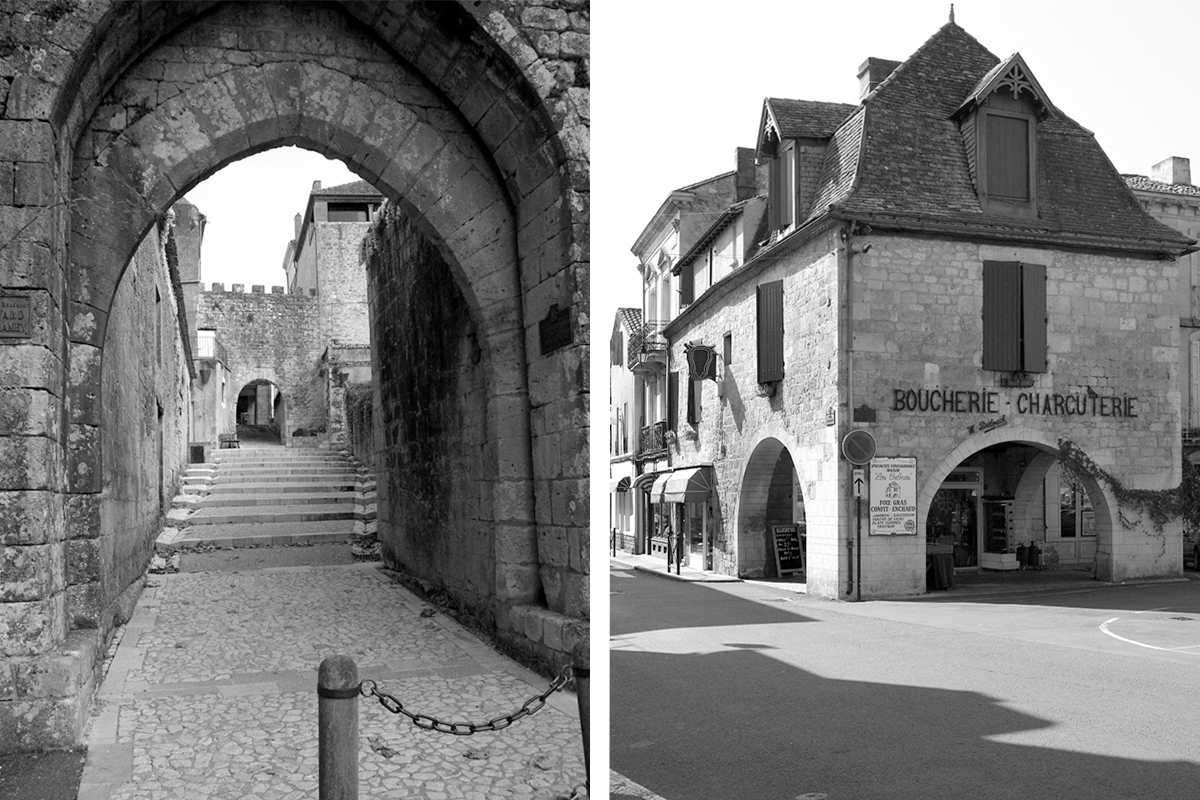 Selected images from John Reps's photographic documentation of bastide towns in southern France from which he curated and installed two exhibitions at the college during his career. images / John Reps
Selected images from John Reps's photographic documentation of bastide towns in southern France from which he curated and installed two exhibitions at the college during his career. images / John RepsAmong Reps's many fascinations were what he called the "Glorious Bastides," 13th-century towns in the south of France where the market square is the natural site of daily trade and weekly markets. An avid photographer with a keen eye, Reps documented many of the bastides beginning in the 1950s and continued for decades afterward.
"John frequently dropped in on newer faculty and delighted in their interests and lives outside of Sibley Hall," says Professor John Forester, a colleague in CRP.
"Indeed, well into his 90s, John came to his Sibley Hall office most days of the week. He sorted his photos of the French bastides, puzzled out unidentified views of early 19th-Century American cities, or worked on an unpublished manuscript about Savannah, Georgia, and far more. He did all this with a wry wit, a disarming humility, a generosity of spirit, and a keen intelligence, but never too solemn to withhold a joke," according to Forester.
Assistant Professor Linda Shi is one of the newer CRP faculty Reps visited.
"You could always expect him to knock on your door unexpectedly with a USB stick of historic maps that may be of interest to an ongoing class, or to pull you into his office to mull over the age or meaning of a painting he'd discovered," she says.
"Realizing I knew nothing about Cornell's history when I began teaching here in 2017, he gave me his copy of Andrew Dixon White's weighty two-volume autobiography and sternly asked a week later if I was ready for a quiz," Shi says. "Another time, he presented me with a framed black and white photo he'd taken in the 1960s of a woman at the base of a long and steep set of stairs in one of his favorite French hill towns." 'That's you,' he said dryly, 'just starting out on your academic career.'"
Reps's influence springs from decades of scholarship for which he was awarded fellowships by the Guggenheim Foundation (1958), Eisenhower Exchange Fellowships (1959), and Fulbright Commission (1950-51) (1965-66).
Well-known for his wit and revered for his scholarship within AAP, Reps's reputation and legacy extend far beyond Cornell. Other fellowships came from the National Endowment for the Humanities (1973-74) and The Australian National University (1989 and 1992). He was invited as a visiting professor or scholar at the University of California–Berkeley (1958), the Institute of Social Studies, The Hague (1965-66), University of North Carolina (1982), Washington State University (1983), Beijing University (1988), and The Chinese University of Hong Kong (1998).
Reps's career is particularly remarkable in its unique growth to great heights without his having received a Ph.D., though the University of Nebraska conferred on him the honorary degree of Doctor of Arts and Letters in recognition of his scholarship in 1985. Earlier that year, the University of Georgia appointed him a Bicentennial Distinguished Visiting Professor. In 1984, the Association of Collegiate Schools of Planning recognized him with its biennial award for Distinguished Service to Education in Planning. In 1996, the American Planning Association designated Reps a Planning Pioneer, citing him as the father of modern American city planning history. And in 2021, the University of Notre Dame School of Architecture posthumously honored Reps with the Henry Hope Reed Award for his work that is "integral to the understanding and practice of architecture and urbanism today."
"His reputation was truly world-wide. When CRP faculty lectured abroad, we knew to expect audience members' questions, acknowledgments, and memories of John. After my talk at University College, London, Carl Steinitz, the distinguished ex-chair of Harvard's landscape architecture department, asked me, 'How is John Reps? I took an undergraduate course from him that changed my life, and I've always been grateful.'" — Professor John Forester, CRP
Recent AAP exhibitions and programs on Reps's career include a lecture he gave at AAP marking his 90th birthday, in November 2011: "John Reps: How Gotham Got Its Grid: The Inside Story of Manhattan's City Plan." In a 2015 AAP exhibition, Reps showed a selection of images from his French bastides photography collection titled "John Reps: Glorious Bastides: A Journey Through Time | Cornell AAP" that was followed four years later by an exhibition of photographs of the bastide town of Monpazier. The Cornell University Library Digital Collections Portal currently holds and has made Reps's entire photography collection accessible to the world.
The 2018 National Conference on Planning History held a panel focused on the impact of Reps's contribution to American planning, hosted by the Society for American City and Regional Planning History, of which Reps is a founder. Titled "The Making of Urban America: Reflections on John Reps's Legacy," the panel focused on how Reps's seminal book helped to frame and define the emerging subfield of planning history, helped to shape subsequent works by Reps and others, and showed how planning history had evolved since the book's 1965 release, as well as what aspects of the volume framed ongoing explorations of planning history.
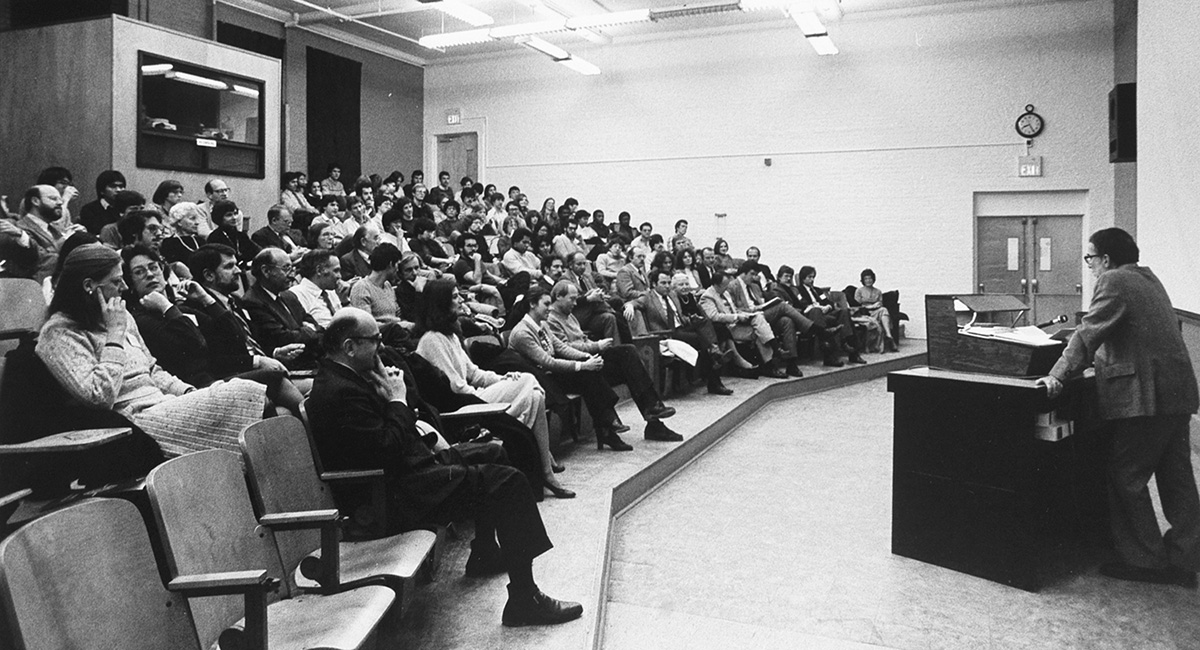 John Reps (right) giving a lecture as part of the Thomas Mackesey Lecture Series in the Olive Tjaden Auditorium, 1982. image / provided
John Reps (right) giving a lecture as part of the Thomas Mackesey Lecture Series in the Olive Tjaden Auditorium, 1982. image / providedMy first personal contact with Cornell came early in the year in a letter that John Reps had written on his portable typewriter informing me that I'd been admitted to graduate school. That fall, I took his lecture course — yes, with slides. For someone who had just finished four years of engineering school, John's slides of colorful playgrounds in Sweden, delightful streetscapes in well-organized cities, and maps or birds-eye views of colonial city plans — well, this was almost pure delight. And yes, I've saved his letter. — Professor Emeritus William Goldsmith, CRP
"How best to remember John Reps?" muses Professor Michael Tomlan, Reps's former student, now director of the Historic Preservation Planning Program, and a friend of many years.
"In his own way, he provided everyone with the means. In the corridor of West Sibley Hall outside of his former office is a bronze plaque that celebrates his contributions. Above the plaque hangs a duster that John provided for regular cleaning!"
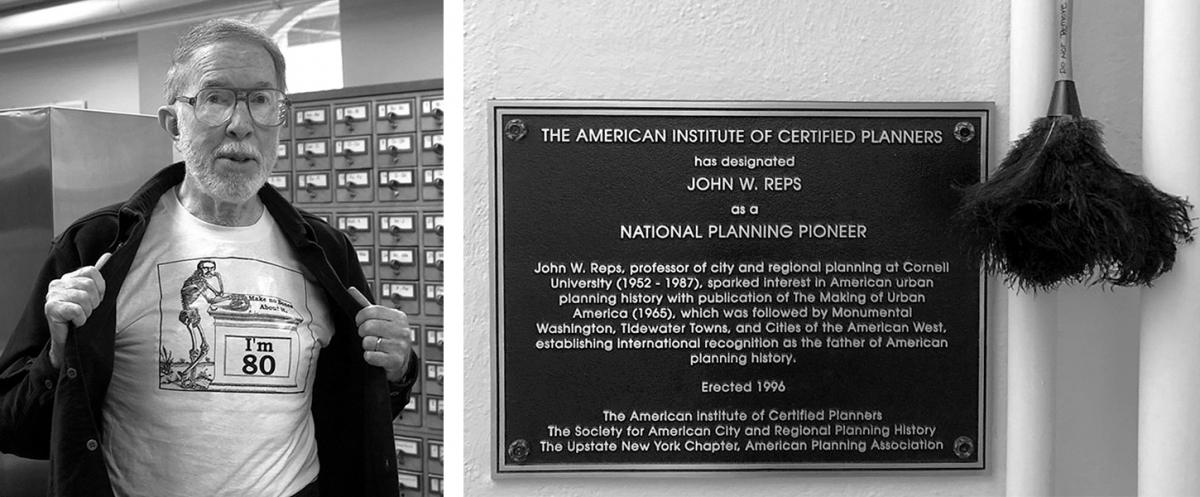 John Reps was well known for his character, wit, and humor and respected both within AAP and well-beyond for his long career of many accomplishments and pioneering contributions to the planning discipline. left: John Reps, Sibley Hall, 2001. William Staffeld / AAP; right: A plaque mounted by the department in honor of John Reps and feather duster provided by Reps for regular cleaning. image / Michael Tomlan
John Reps was well known for his character, wit, and humor and respected both within AAP and well-beyond for his long career of many accomplishments and pioneering contributions to the planning discipline. left: John Reps, Sibley Hall, 2001. William Staffeld / AAP; right: A plaque mounted by the department in honor of John Reps and feather duster provided by Reps for regular cleaning. image / Michael TomlanChusid echoes what many felt in Reps's presence.
"Personally, his visits to my office felt like a benediction, an unspoken affirmation that I was doing okay as the chair and as a colleague. His grace, modesty, sharp mind, love of CRP, and never-flagging enthusiasm for learning and teaching will be deeply missed. As will be the person, our John Reps."






